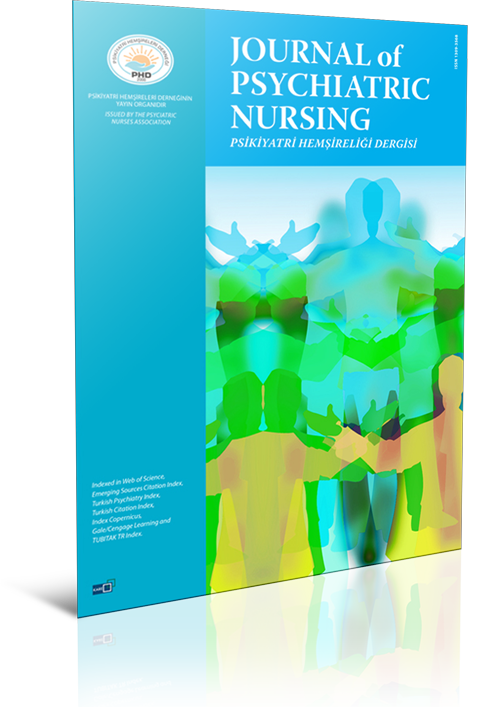
Investigation of the relationship between early stage maladaptive schemas and anger levels in people with substance-use disorders
Bilge Dilek Soyaslan, Celale Tangül ÖzcanDepartment of Psychiatric Nursing, Health Sciences University, Gülhane Training and Research Hospital, Ankara, TurkeyINTRODUCTION: This study was conducted as a case-control study to investigate the relationship between early stage maladaptive schemas and anger levels in people with and without substance-use disorders.
METHODS: The sample for the investigation included a case group of 73 patients who presented to a military hospital
mental health and diseases polyclinic and a control group of 75 current soldiers and rankers performing military service
who presented to the same hospital. Sociodemographic Data Collection Form-1 was applied to the case group and
Sociodemographic Data Collection Form-2 was applied to the control group, while the Young Schema Questionnaire
Short Form-3 (YSQ-SF3), the State-Trait Anger Scale and the State-Trait Anger Expression Inventory were applied to both
groups. For the evaluation of the data, the chi-square test, Mann Whitney U test and correlation analysis were used.
RESULTS: In comparing the case group and control group in terms of sociodemographic characteristics, it was observed
that, with the exception of intra-family relationships and family economic status levels, for which significant differences
were seen (p<0.05), no statistically significant differences were found (p>0.05). When the schema domains of the case
group and control group were evaluated, Disconnection, Impaired Autonomy, High Standards, and Impaired Borders
schema domains and subscale components were significantly higher than those of the control group (p<0.05). Comparison
of the anger styles between the case group and control group showed that those in the case group had significantly
higher points in Trait Anger, Anger In and Anger Out than those of the control group (p<0.05). In the correlation
analysis performed, a positive moderate relationship was found between Emotional Deprivation and the Self Sacrifice
schema sub-scale and Anger In for the case group and control group, while a positive moderate relationship was also
found between Approval Seeking, High Standards, Punitiveness and Other-directedness and Trait Anger, Anger In and
Anger Out, but a negative weak relation with Anger Control.
DISCUSSION AND CONCLUSION: Evaluation of the study data showed that the case group, which had substance-use disorders, had an
excess of early stage maladaptive schemas, and there was a significant level of difference between the case group and
control group in terms of anger levels.
Madde kullanım bozukluğu olan kişilerde erken dönem uyumsuz şemalar ile öfke düzeyleri arasındaki ilişkinin incelenmesi
Bilge Dilek Soyaslan, Celale Tangül ÖzcanSağlık Bilimleri Üniversitesi, Gülhane Eğitim ve Araştırma Hastanesi, Psikiyatri Hemşireliği Bilim Dalı, AnkaraGİRİŞ ve AMAÇ: Bu çalışma, madde kullanımı olan ve madde kullanımı olmayan kişilerde erken dönem uyumsuz şemalar ile öfke düzeyleri arasındaki ilişkinin incelenmesi amacıyla bir vaka-kontrol çalışması olarak yürütülmüştür.
YÖNTEM ve GEREÇLER: Bu araştırmanın örnekleminin vaka grubunu bir askeri hastanede Ruh Sağlığı ve Hastalıkları AD. Polikliniklerine başvuran 73 hasta, kontrol grubunu ise, aynı hastane içerisinde bulunan bir askeri birlikte vatani görevini yerine getirmekte olan 75 er ve erbaş oluşturmuştur. Vaka grubuna Sosyodemografik Veri Toplama Formu-1; kontrol grubuna Sosyodemografik Veri Toplama Formu-2 uygulanmıştır. Aynı zamanda her iki gruba da Young Şema Ölçeği Kısa Form-3 (YŞÖ-KF3), Sürekli Öfke ve Öfke İfade Tarzları Ölçeği (SÖÖTÖ) uygulanmıştır. Verilerin değerlendirilmesinde Ki- kare analizi, Mann Whitney U testi ve korelasyon analizinden yararlanılmıştır.
BULGULAR: Vaka ve kontrol grubu sosyodemografik özellikler açısından karşılaştırıldığında iki grup arasında istatistiksel olarak anlamlı bir fark bulunmazken (p>0.05). Aile içi ilişkiler ve aile ekonomik düzeyi açısından gruplar arası fark bulunmuştur (p<0.05). Grupların şema alanları incelendiğinde; Kopukluk, Zedelenmiş Otonomi, Yüksek Standartlar, Zedelenmiş Sınırlar şema alanları ve alt boyutlarına ait puanları, vaka grubundaki kişilerin puanlarının anlamlı düzeyde daha yüksek olduğu bulunmuştur (p<0.05). Öfke tarzları incelendiğinde ise; Sürekli Öfke, Öfke İçte ve Öfke Dışa puanları, vaka grubundaki kişilerden anlamlı düzeyde daha yüksek olduğu bulunmuştur (p<0.05). Yapılan korelasyon analizinde kontrol grubu ile vaka grubu arasında Duygusal Yoksunluk, Kendini Feda şema alt boyutu ile Öfke İçte puanı arasında pozitif yönlü orta düzeyde ilişki olduğu saptanmıştır. Vaka grubunda Onay Arayıcılık, Yüksek Standartlar, Cezalandırıcılık, Diğerleri Yönelimlilik alt boyutu ile Sürekli Öfke, Öfke İçte ve Öfke Dışa puanları ile pozitif yönlü orta düzeyde ve Öfke Kontrol puanı ile negatif yönde zayıf ilişki olduğu saptanmıştır.
TARTIŞMA ve SONUÇ: Araştırma verileri değerlendirildiğinde madde kullanım bozukluğu olan vaka grubunun erken dönem uyumsuz şemaların fazlalığı ve öfke seviyelerinde kontrol grubuna göre anlamlı düzeyde farklılık bulunmuştur.
Manuscript Language: Turkish


















